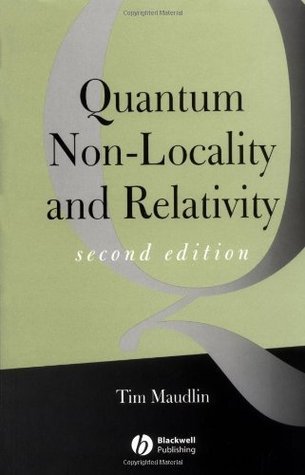What do you think?
Rate this book


296 pages, Paperback
First published January 1, 1994
My foremost goal in composing the book has been to make it comprehensible to the non-specialist. [...] Unfortunately, much of the work done by philosophers presupposes a considerable amount of familiarity with the physics. This is particularly sad since the physics is not, in most cases, very complicated. (Maudlin, vii)
It is true that the signal propagation may be isotropic only in the rest frame of the emitter, but so too are water waves isotropic only in the rest frame of the water. The laws of nature do not pick out any particular frame, only the distribution of matter does. (Maudlin, 94)
"I fear that many readers may be frightened off from the topic by unnecessary formalization, so I have tried to keep the mathematical complexity of the discussion to a minimum. But on the other hand, I have not wished to drop to the level of vague metaphor which sometime infects popularizations. Every compromise between rigor and simplicity is a bargain with the devil. (Maudlin, vii)
"Furthermore, as the velocity approaches the speed of light, the mass approaches infinity, and hence it requires unbounded amounts of energy to get the particle to go faster. Given that only finite amounts of energy are available, it would follow that no particle which travels below the speed of light can ever be accelerated to, or beyond, that speed. So the speed of light does serve as a limit on the velocities of particles which start out traveling at sublight speeds". (Maudlin, pg. 63)
"The Lorentz transformations and the relativistic mass increase do not per se rule out superluminal particles (tachyons), but only prohibit the acceleration of particles through the light barrier. Tachyons must be born traveling faster than light and (as we will see) cannot be slowed to sublight speeds." (Maudlin, pg. 65)
"If x′, x′′, y′ and y′′ are all numbers that lie between -1 and 1 (inclusive), then the quantity x′y′ + x′y′′ + x′′y′ - x′′y′′ lies between -2 and 2 (inclusive)"
Case 1: y' > y''
(i) x'y' + x'y'' + x''y' - x''y''
= x'*(y' + y'') + x''*(y'-y'')
≤ y' + y'' + y' - y''
≤ y' + y' = 2y' ≤ 2
(ii)
x'y' + x'y'' + x''y' - x''y''
= x'*(y' + y'') + x''*(y'-y'')
≥ -(y' + y'') - (y'-y'')
= - y' - y' = -2y' ≥ -2
By (i) and (ii), -2 ≤ x'y' + x'y'' + x''y' - x''y''≤ 2 if y' > y''.
Case 2: y' = y''
Then: x'y' + x'y'' + x''y' - x''y'' = x'(2y')
= 2(x'y'), which is obviously bounded by -2 and 2.
Case 3: y' < y''
(i) x'y' + x'y'' + x''y' - x''y''
= x'*(y' + y'') + x''*(y'-y'')
≤ y' + y'' + y' - y''
≤ y' + y' = 2y' ≤ 2
(ii)
x'y' + x'y'' + x''y' - x''y''
= x'*(y' + y'') + x''*(y'-y'')
≥ -(y' + y'') + (y'-y'')
= - y'' - y'' = -2y'' ≥ -2
By Cases 1 - 3, we prove the stated lemma as above.